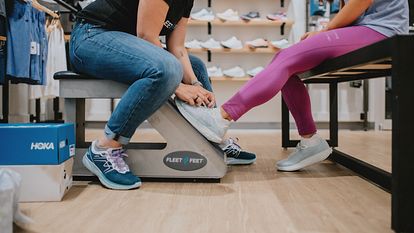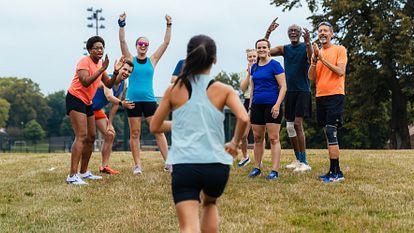
Can Running Shoes Be Used for Walking?
Can running shoes be used as walking shoes?
The short answer: yes.
Running shoes and walking shoes have similar qualities that make them ideal for being active. While running shoes are designed to be durable for the rigorous demands of running, they are excellent as walking shoes, too.
The qualities that make running shoes ideal for running also make them great for walking:
- Cushioned midsoles absorb impact
- Lightweight mesh or knit uppers breathe easily to keep you comfortable
- Lacing systems create a secure fit
- Durable materials last for hundreds of miles
While most running shoes offer a generous amount of rubber on the outsole that often increases traction on pavement, it’s typically not rated specifically for slip resistance. Check the shoe’s specs to see if it’s rated for slip resistance on other surfaces, like tile or job-site floors, and against water, oil and soap.
Whatever shoes you choose, though, it’s important to find the right fit. Your shoes—both walking shoes and running shoes—should have about a thumb’s width of space between the end of your big toe and the front of the shoe. They should also be wide enough that your feet don’t spill over the sides of the shoe; if they do, try out wide sizes.
Pay attention to the heel-to-toe drop, too. This is the difference between the height of the heel and the height of the forefoot and can impact your stride as you run or walk.
Above all else, your running and walking shoes should feel comfortable and supportive as soon as you put them on---no break-in period required.
The Difference Between Walking and Running

Walking and running are very similar activities with one big difference: time spent in the air.
As runners run, they will have both feet in the air at the same time for a brief moment. It happens during the turnover from foot to foot. That fraction of a second in the air means a runner will put more stress on their body as their foot strikes the ground when compared to a walker.
Walkers, on the other hand, always have at least one foot on the ground. Since walkers don’t go airborne during their turnover, there’s less stress on their bodies than runners.
But don’t let the lower intensity of walking fool you—there are loads of health benefits of walking for exercise, like decreasing cardiac risk factors such as high cholesterol, blood pressure, diabetes, obesity, vascular stiffness and inflammation, and mental stress. Plus, just like running, walking is an excellent way to unplug and reduce stress.
When Running Shoes Shouldn't Be Used for Walking
While the majority of running shoes make great walking shoes, some running shoes are designed specifically for a runner's gait. Shoes made with carbon-fiber plates and rocker shapes propel you forward into the toe-off phase as fast as possible to help you pick up the pace. However, this technology isn't conducive for a natural walking gait. It's best to leave these shoes for race day, and stick to more traditional models for walking.
How Long Do Walking Shoes Last?
Just like running shoes, your walking shoes should last between 300 and 500 miles. Keep in mind that if you're using the same pair of shoes for running and walking, the miles will accumulate more quickly -- even though walking is a lower-impact activity. We recommend tracking your mileage on an app like Strava or Garmin so you'll know when it's time for a fresh pair.
This article is part of our guide for How to Start Running.



Join our Newsletter
Get deals, events, and more.
Connect with Fleet Feet
Get involved on social media.
Find a Location
Fleet Feet has over 250 locations nationwide!
Find a Store